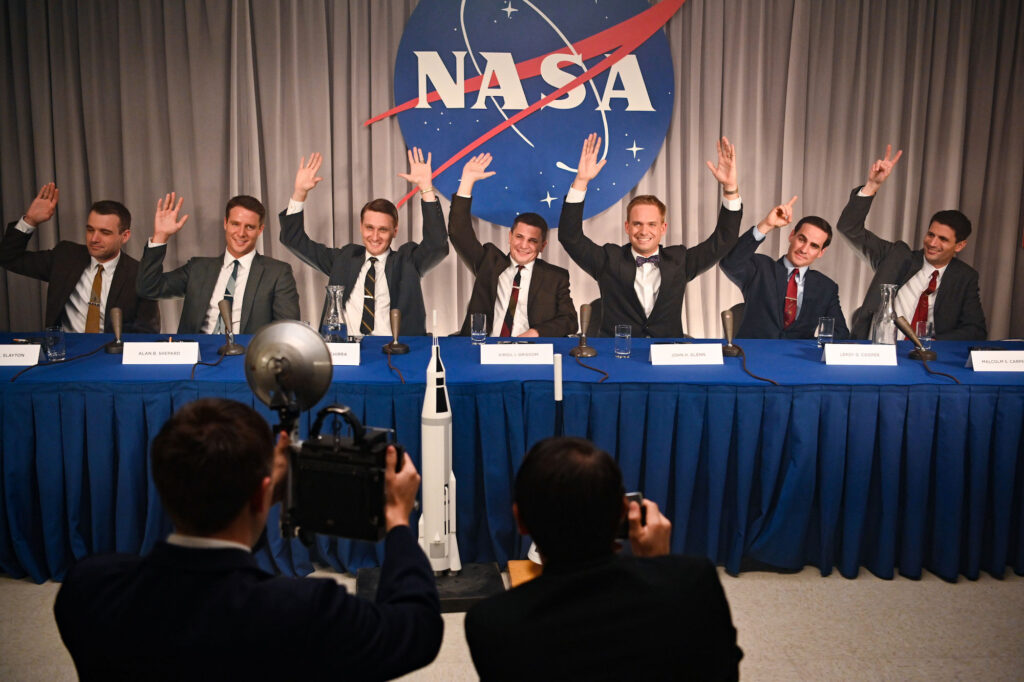
Author’s Note: Welcome to the first installment of Eyelands in the Stream, an ongoing series of reports on movies and television.
On Thursday, February 18, the world held its breath as NASA’s Mars 2020 spacecraft hurtled its last few kilometers toward Jezero Crater, a long-dry lakebed on Mars. After years of planning and months of flight time between Earth and the Red Planet, the success or failure of the $2.4 billion mission all depended on this ultimate seven minutes or so of descent, where so much can potentially go wrong.
For historical perspective, it pays to note that roughly half the missions ever sent to the Martian surface have failed; to date the US is responsible for nine of the eleven successes, with the other two belonging to the Soviets, who actually got there first, all the way back in 1971. As often as not, failure occurs in that brief, final leg of the journey, between the moment the spacecraft enters the atmosphere and that when it rests on the planet’s surface.
NASA’s first Martian landers, Viking 1 and 2, touched down in 1976 just like the old lunar landers did — using thrusters to slowly descend to a soft landing (although unlike on the Moon, these crafts’ deceleration was augmented by parachutes). Over time the Viking-era hardware evolved significantly, adopting wild new landing techniques straight out of science fiction. The Mars Pathfinder lander (with its Sojourner rover, first remote Earth vehicle to be used on any other celestial body) was slowed with parachutes and retro-rockets before bouncing across the Martian terrain to an eventual stop in a cluster of inflated airbags. Twin rovers Spirit and Opportunity were deposited on Mars in this way, too. In 2012 the Mars Science Laboratory (with its still-active rover Curiosity) was gently placed on Martian soil, just as Perseverance was this week, using a system called a “sky crane,” which is truly some Wile E. Coyote shit.
Meanwhile back on Earth, technology isn’t the only thing that has evolved at NASA/JPL since the ’70s. The Viking team was, like much of the space industry before it, comprised mostly of white dudes, as evidenced in this photo of Space Flight Operations crew on the day Viking 1 landed on Mars in July 1976. By comparison, the Mars program of today, which employs nearly 400 people, is a veritable whole earth sampler of experts from vastly divergent backgrounds; 60 years in, our exploration of life beyond Earth is looking less and less like the exclusively starched-whiteness of The Right Stuff and more like the rainbow coalition representing humanity in Star Trek.
The original Trek universe, of course, was famously conspicuous from the get-go in its depiction of a future that is vastly more integrated in terms of both race and gender than typical sci-fi fare of its time — and more so than real life, too. In those days NASA was still notoriously white — enough so to make a major story decades later of the long-overdue recognition of the critically important but perennially-obscured “Hidden Figures” — African-American women who worked as human calculators before the necessary computing power existed. (Also white enough to inspire Gil Scott-Heron’s withering “Whitey on the Moon,” and much later, A Tribe Called Quest’s “The Space Program.”)
But the white chokehold on space supremacy was not to last. In the decades since the Mercury program — largely spurred by the Russians’ brisk cash business in taking up astronauts from many nations — space exploration has become accessible to scientists and governmental organizations representing people all over the globe, and cooperation among international space agencies and talent pools is now the norm. At this moment, citizens of 41 countries, representing many ethnic and cultural backgrounds, have traveled in space, and both China and the United Arab Emirates placed their own crafts in orbit around Mars in February, joining NASA, the Russians and India in the list of nations operating current Mars missions. We are finally showing a much more accurate picture of humanity’s face to the cosmos.

Which brings me back around to TV and movie depictions of space travel, a major genre of entertainment long dominated by Hollywood studios and lily-white casts. The aforementioned Star Trek stood out in its day in a sea of whitewashed space fare: Lost in Space, Forbidden Planet, Space: 1999, 2001: A Space Odyssey, all the way back to Flash Gordon in the 1930s, there is nary a nonwhite face to be seen. Even in Star Wars, with the exception of Lando Calrissian, the original trilogy of films depicts a galaxy populated by a bunch of white people and assorted exotic aliens. Lucasfilm et al have addressed this in more recent productions within the franchise, adopting an aggressively diverse casting strategy, to mixed and often caustic reactions from the bowels of fandom.
But now it’s 2021 and the computer-driven movie magic behind today’s big-budget Hollywood blockbusters has become more powerful and substantially less expensive, finally allowing filmmakers in other nations (and with smaller budgets) to create eye-popping, IMAX-worthy popcorn flicks with the best of them. In these movies we see a future in space that is not centered entirely on the adventures of groups of white guys, perhaps peppered with token characters for “spice” — but rather a vision of humanity beyond the bounds of earth in which individuals from anywhere on it have an equal chance to contribute to the grand story of our species’ peregrination into the unknown.
In The Wandering Earth (China, 2019), our sun begins transforming into a red giant, expanding and threatening to destroy Earth within a few generations. In response, a one-world government is formed and a planetwide engineering project gets underway, its purpose to physically move the whole planet across open space to the Alpha Centauri system using massive fusion-powered thrusters. This plunges the globe into freezing temperatures, forcing those who manage to survive into vast underground cities.
Everything is going to plan until Earth is steered near Jupiter in order to use its gravitational pull as a speed boost. Calamity strikes when some of the thrusters fail, causing Earth to veer dangerously close to the giant planet. Taking more pages from the Hollywood playbook, a scrappy team of misfits is dispatched to fix the problem before it’s too late, leading to some nail-biting moments and one scene that will no doubt come to be regarded as iconic in the history of sci-fi cinema.

The Wandering Earth made $700 million at the box office, becoming the third-highest-grossing film of 2019 — and the third-highest-grossing non-English film of all time. Westerners with access to Netflix can stream it right into their own homes and confirm for themselves that given the opportunity, people on the other side of the planet will tend to produce the same kind of by-the-numbers sci-fi/action spectacles as we do right here in the States. The Wandering Earth is not 2001: A Space Odyssey, but for the average fan of wild-ride flicks, it stands up absolutely as well as — and frankly better than a number of — American productions in the same genre.
And now South Korea, longtime home to many top animation and visual effects houses, has thrown its hat in the ring with the American streaming debut of Space Sweepers, also on Netflix, in February 2021.
In contrast to the grim drama and tension of The Wandering Earth, reminiscent of bleak epics such as Deep Impact, the upbeat Space Sweepers takes a page from sassy Marvel Cinematic Universe team-ups like Guardians of the Galaxy and even The Avengers. There’s the standard team of misfits, but they are at least distinguishable from one another, and even allowed a modicum of character development. There’s lots of action, but there’s also jokes — some of them pretty funny.
Space Sweepers takes place in a not-too-distant future in which, like Silent Running and WALL-E, an overly polluted Earth is driving mankind into space for survival. A megaconglomerate — the nefarious UTS Corporation —has built the ultimate gated community on a luxurious residential space station, but those too poor to become its “citizens” are largely doomed to die slowly on the ground below. Our heroes, the crew of the Korean salvage ship Victory, live a precarious Wild West existence in between, picking up space debris for money and living like outlaws.
When a mysterious child falls into their hands, the crew finds themselves in the crosshairs of the most powerful man alive, the unnaturally long-lived founder and head of UTS. Though the child is reported to be a sophisticated android with a powerful atom bomb in its belly, the truth is something else entirely — and this revelation motivates each of the main characters to re-evaluate their priorities in their own way.
Like The Wandering Earth, the film resolves on an optimistic note. Unlike the subtitled Chinese film, however, Space Sweepers is dubbed into English in the official US streaming version, though it is worth noting that in this film’s depiction of the year 2092, automatic translators are common and a gumbo of languages is spoken interchangeably, with English, Spanish, Tagalog, German and other tongues in the mix. It really does point out the smallness of a completely interconnected world in which national borders and cultural baggage take back seats to the common struggles and shared experiences of all humanity.
To my taste, Space Sweepers is a more satisfying film than The Wandering Earth, but I am glad to have watched both. As a fan of science fiction and space movies, I know it’s only a matter of time before the next such great film is made — and both these movies provide evidence that with today’s easy ability to make manifest on screen the wildest leaps of imagination, that next great movie — like the next real-life visionary in humanity’s quest for space — might come from just about anywhere on Earth.



